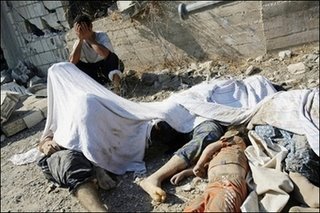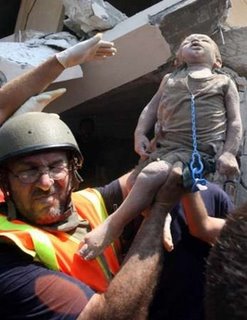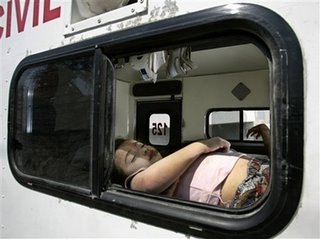 Certainly, the photographs are distressing, and indeed they are meant to be. As this piece tells us:
Certainly, the photographs are distressing, and indeed they are meant to be. As this piece tells us:Until recent years, images of civilian casualties in wars often took days to appear in newspapers, but now they can be captured and transmitted around the world to newspaper Web sites, where they are posted immediately, adding to the shock value that sketchy words by reporters often cannot capture. This happened again Sunday morning in the case of the Israeli air strike on the Lebanese village of Qana that left dozens dead, reportedly at least half of them children sleeping in their beds overnight.But the photographers, it seems, are not too fussy about how they go about "adding to the shock value". These two sequences illustrate the extent to which photographers on the scene are prepared to ensure that the "shock value" is maximised.
The photos, taken by The Associated Press, Reuters, and others, showed bodies in the rubble, or being taken away; survivors digging or wailing…
 In this first of the two sequences, we see a shot by Reuters and taken by Adnan Hajj, timed at 2:21 pm. It has the caption:
In this first of the two sequences, we see a shot by Reuters and taken by Adnan Hajj, timed at 2:21 pm. It has the caption:Rescuers pull the body of a toddler victim of an Israeli air raid on Qana that killed more than 60 people, the majority of them women and children, in south Lebanon, July 30, 2006.Note the "rescue worker" in the foreground, complete with olive green military-style helmet and fluorescent jacket, with what appears to be a flack jacket underneath. His glasses, "designer stubble", blue tee-shirt and jeans make him quite a distinctive figure. Note also, he has a radio in his jacker pocket and he has bare hands, things which becomes relevant later.
 The next shot in this sequence is credited to AP's Kevin Frayer. Timed at 4.09 pm, it shows the same "rescue" worker, and has this caption:
The next shot in this sequence is credited to AP's Kevin Frayer. Timed at 4.09 pm, it shows the same "rescue" worker, and has this caption:Lebanese Red Cross and Civil Defense workers carry the body of a small child covered in dust from the rubble of his home that was hit in an Israeli missile strike in the village of Qana, east of the port city of Tyre, Lebanon, Sunday. Lebanese Red Cross officials said 56 people died in the Israeli assault on the village, including 34 children. Rescuers dug through the debris to remove dozens of bodies.This is horrific, but a scrutiny of the framing does suggest that the subject is offering the victim to the photographer.
 Just in case you missed it, however, we get another view, courtesy of Reuter's Adnan Hajj, with a time given of 4:30 pm - some 20 minutes after the first shot. The caption reads:
Just in case you missed it, however, we get another view, courtesy of Reuter's Adnan Hajj, with a time given of 4:30 pm - some 20 minutes after the first shot. The caption reads:A rescuer carries the body of a toddler victim of an Israeli air raid on Qana that killed more than 60 people, the majority of them women and children, in south Lebanon, July 30, 2006.Interestingly, in this sequence, the pocket radio is missing. And, although the positioning of the child looks the same, the angle of the shot looks to be about ninety degrees from the first, but in each case, the "worker" is facing towards the camera. The shots are clearly posed.
 But now, timed at 12:45 pm, an hour and twenty minutes before the child's body is pictured being pulled from the ruins, we get a picture from AP's Kevin Frayer of the same child's body being paraded by our ubiquitous helmeted rescue worker.
But now, timed at 12:45 pm, an hour and twenty minutes before the child's body is pictured being pulled from the ruins, we get a picture from AP's Kevin Frayer of the same child's body being paraded by our ubiquitous helmeted rescue worker.Lebanese Red Cross and Civil Defense workers carry the body of a small child covered in dust from the rubble of his home that was hit in an Israeli missile strike in the village of Qana, east of the port city of Tyre, Lebanon, Sunday, July 30, 2006. Lebanese Red Cross officials said 56 people died in the Israeli assault on the village, including 34 children. Rescuers dug through the debris to remove dozens of bodies.
 At 12.53 pm, after an interval of eight minutes, Frayer photographs the child's body again, from a different angle. The caption is the same. This time, though, our helmeted worker is showing some distress, which was absent in the previous photograph.
At 12.53 pm, after an interval of eight minutes, Frayer photographs the child's body again, from a different angle. The caption is the same. This time, though, our helmeted worker is showing some distress, which was absent in the previous photograph.The photographs show the characters moving down the hill, with little distance between the scenes, which suggest that they have been taken sequentially and spontaneously. But they have not. The eight minute interval has allowed a crowd to gather around "green helmet". Furthermore, "orange jacket" has switched from left to right. Note also the tee-shirted man in the centre of the picture.
 Then, timed at 1:01 pm, eight minutes on, we get another picture from Frayer. Once again, the caption is the same but this time the child's body is being paraded aloft by our ubiquitous helmeted rescue worker, but the tee-shirted character had moved from centre to right and is taking his turn to displaying his emotion to the camera. The UN soldier in the background has turned away, confirming a time lapse. The scene is clearly staged, as have been those preceding it.
Then, timed at 1:01 pm, eight minutes on, we get another picture from Frayer. Once again, the caption is the same but this time the child's body is being paraded aloft by our ubiquitous helmeted rescue worker, but the tee-shirted character had moved from centre to right and is taking his turn to displaying his emotion to the camera. The UN soldier in the background has turned away, confirming a time lapse. The scene is clearly staged, as have been those preceding it. Next, we have the second of the two sequences, the first shot of which, timed at 7.21 am shows a dead girl in an ambulance. Taken by AP, the caption reads:
Next, we have the second of the two sequences, the first shot of which, timed at 7.21 am shows a dead girl in an ambulance. Taken by AP, the caption reads:Among others, the body of a child recovered under the rubble of a demolished building that was struck by Israeli war plane missiles at the village of Qana near the southern Lebanon city of Tyre, is placed in an ambulance Sunday July 30.
 In the next frame, we have the same girl, this time apparently being placed in the ambulance. Also taken by AP,this time by Mohammed Zaatari the caption here reads:
In the next frame, we have the same girl, this time apparently being placed in the ambulance. Also taken by AP,this time by Mohammed Zaatari the caption here reads:A Lebanese rescuer carries the body of a young girl recovered from under the rubble of a demolished building that was struck by Israeli warplane missiles at the village of Qana, near the southern city of Tyre, Lebanon, Sunday, July 30, 2006. Dozens of civilians, including many children, were killed Sunday in an Israeli airstrike that flattened houses in this southern Lebanon village - the deadliest attack in 19 days of fighting.Intriguingly, though, the dateline given is 10.25 am, three hours after she has already been photographed in the ambulance.
 Also from AP's Nasser Nasser, we see the same worker, showing obvious distress, carrying the same girl. But now he is wearing his fluorescent jacket and helmet and has acquired latex gloves. He has also got his radio back. The photograph is timed at 10.44 am and the caption reads:
Also from AP's Nasser Nasser, we see the same worker, showing obvious distress, carrying the same girl. But now he is wearing his fluorescent jacket and helmet and has acquired latex gloves. He has also got his radio back. The photograph is timed at 10.44 am and the caption reads:A civil defense worker carries the body of Lebanese child recovered from the rubble of a demolished building that was struck by an Israeli airstrike at the village of Qana near the southern Lebanon city of Tyre, Sunday, July 30, 2006. Israeli missiles struck this southern Lebanese village early Sunday, flattening houses on top of sleeping residents. The Lebanese Red Cross said the airstrike, in which at least 34 children were killed, pushed the overall Lebanese death toll to more than 500.
 Here we are now, same "worker" and same girl, but this time it is done for the benefit of EPA, the photographer, Mohamed Messara, the worker rushing towards a uniformed Red Cross worker. This caption (without a time) reads:
Here we are now, same "worker" and same girl, but this time it is done for the benefit of EPA, the photographer, Mohamed Messara, the worker rushing towards a uniformed Red Cross worker. This caption (without a time) reads:A rescue worker carries the body of a Lebanese girl after an Israeli air strike on the village of Qana, east of the southern port city of Tyre, on Sunday 30 July 2006. At least 51 people were killed, many of them children, and several others wounded in the raid Sunday, witnesses and rescue workers said.
 But now, for the benefit of AFP, the photgraph taken by Nicolas Asfouri, we have the same unfortunate child being handled by another worker, the original worker showing in the background, having passed the casualty on. The timing of the photograph is 7.16 pm (now apparently corrected to 6:46 am) and the caption reads:
But now, for the benefit of AFP, the photgraph taken by Nicolas Asfouri, we have the same unfortunate child being handled by another worker, the original worker showing in the background, having passed the casualty on. The timing of the photograph is 7.16 pm (now apparently corrected to 6:46 am) and the caption reads:A rescue worker puts the body of a dead girl on a gurney after Israeli air strikes on the southern Lebanese village of Qana. Israel agreed to temporarily halt air strikes in south Lebanon a day after 52 people were killed, many of them sleeping children, when Israeli warplanes bombarded the Lebanese village of Qana, triggering global outrage and warnings of retribution for alleged "war crimes".Remember, however, earlier in the sequence, the girl is being carried to the ambulance, by the other worker, sans jacket, helmet and gloves.
 Finally, in this sequence, we get another shot from AP's Nasser Nasser, again without a timing but with this caption:
Finally, in this sequence, we get another shot from AP's Nasser Nasser, again without a timing but with this caption:A civil defence worker carries a body of a young Lebanese child recovered from the rubble of a demolished building that was struck by Israeli war plane missiles at the village of Qana near the southern Lebanon city of Tyre, Sunday, July 30, 2006.Whatever else, the event in Qana was a human tragedy. But the photographs do not show it honestly. Rather, they have been staged for effect, exploiting the victims in an unwholesome manner. In so doing, they are no longer news photographs - they are propaganda. And, whoever said the camera cannot lie forgot that photographers can and do. Those lies have spread throughout the world by now and will be in this morning's newspapers, accepted as real by the millions who view them.
The profession of photo-journalism thereby is sadly diminished by them, and the trust in those who took them and in those who carried them is misplaced. Truly, we are dealing with loathesome creatures.
COMMENT THREAD
No comments:
Post a Comment
Note: only a member of this blog may post a comment.